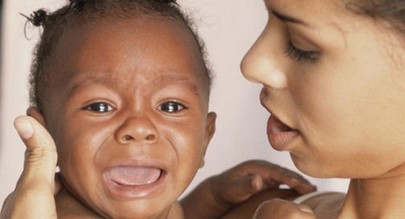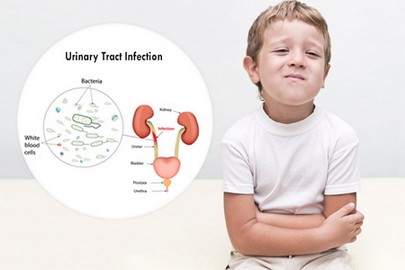Urinary Tract Infection in Babies

Contents:
- Urinary Tract Infections in Babies
- Causes
- Classification of Urinary Tract Infections in Children
- Symptoms of Urinary Tract Infections in Children
- Diagnosis
- Treatment of Urinary Tract Infections in Children
- Forecast and Prevention
Urinary Tract Infections in Babies
Urinary tract infection in children is a general concept that refers to inflammatory processes in different parts of the urinary tract: the upper urinary tract (pyelitis, pyelonephritis, ureteritis) and lower urinary tract infections (cystitis, urethritis).
Urinary tract infections are extremely common in childhood: by the age of five, 1-2 % of boys and 8 % of girls usually have at least one episode of the disease. The prevalence of urinary tract infections depends on the age and gender: more boys get sick often as newborns and infants, and girls usually have the disease at the age from 2 to 15. The practice of pediatric urology and of pediatrics most often deal with cystitis, pyelonephritis and asymptomatic bacteriuria.
Causes
The range of microbial flora, causing urinary tract infection in children depends on the age and sex of a child, the conditions of infection status of intestinal microflora and immunity. In general, the leading bacterial pathogens include enterobacteria, among which Escherichia coli takes the first place (50-90 %). In other cases, Klebsiella, Proteus, enterococci, Pseudomonas Aeruginosa, staphylococci, streptococci, etc. are spread. Acute urinary tract infections in children are usually caused by one type of microorganisms, but in case of frequent relapses and disorders of the urinary system, the development of microbial associations is often detected.
Urinary tract infections in children can be associated with genitourinary chlamydia, mycoplasmosis and ureaplasmosis. They can also be combined with vulvitis, vulvovaginitis, balanoposthitis. Fungal urinary tract infections often occur in weakened children: premature ones, babies suffering from hypotrophy, immune deficiency, anaemia. There is an assumption that the viral infection (Coxsackie virus infection, influenza, adenoviruses, herpes simplex virus type I and II, cytomegalo virus) is a contributing factor to the layering of bacterial infection.
Сonditions, which are accompanied by urodynamic disorders, predispose to the development of urinary tract infection in children: neurogenic bladder, kidney stones, bladder ears, vesicoureteral reflux, pyelectasis, hydronephrosis, multicystic kidney disease, ectopic kidney, ureterocele, phimosis in boys, labial fusion in girls. Urinary tract infections in children often develop on the background of gastrointestinal diseases: dysbacteriosis, constipation, colitis, intestinal infections, etc. Metabolic disorders (dysmetabolic nephropathy in children, glucosuria, etc.) can become risk factors.
The carrying of infection in the urinary tract can occur in case of insufficient hygiene of external genital organs, improper washing techniques of a child, by lymphogenous and haematogenous ways when conducting medical manipulations (bladder catheterization). Boys, who passed through circumcision, suffer from urinary tract infections 4-10 times rarer than uncircumcised ones.
Classification of Urinary Tract Infections in Children

According to localization of inflammatory process, specialists distinguish infections of upper sections of urinary tract: of kidneys (pyelonephritis, pyelitis), ureters (ureteritis) and of lower divisions-bladder (cystitis) and urethra (urethritis).
According to the periods of diseases of urinary tract infections in children, they are divided into the first episode (debut) and relapse. The progress of the recurrent urinary tract infections in children can be supported by unresolved infection, persistence of a pathogen or some reinfection.
According to the manifestation of clinical symptoms, specialists distinguish mild and severe urinary tract infections in children. In case of a mild disease, the temperature reaction is moderate, dehydration is insignificant, a child follows the treatment regimen. Severe urinary tract infection in children is accompanied by high fever, persistent vomiting, expressed dehydration, sepsis.
Symptoms of Urinary Tract Infections in Children
The clinical manifestations of urinary tract infection in a child depends on the localization of microbe-inflammatory process, the period and severity of the disease. Consider the signs of the most frequent urinary tract infections in children: pyelonephritis, cystitis and asymptomatic bacteriuria.
Pyelonephritis in children proceeds with febrile temperature (38-38, 5 °C), cold fits, symptoms of intoxication (sluggishness, paleness of skin, loss of appetite, headache). At the height of intoxication, a child can develop frequent possetings, vomiting, diarrhea phenomenon of neurotoxicosis, meningeal signs. The child has pain in the lumbar region or abdomen; the Murphy's punch sign is positive. At an early age, infections of upper divisions of the urinary tract in children might be lurking under the guise of pylorospasm, dyspeptic disorders, acute abdomen, gastrointestinal syndrome, etc.; elder children can have flu-like syndrome.
Cystitis in children is manifested primarily by dysuric manifestations-frequent and painful mictions in small portions. At the same time, full simultaneous emptying of the bladder is not achieved, there may be episodes of incontinence. In infants, cystitis is often accompanied by stranguria (difficult urination). Crying or anxiety associated with urination, intermittent and weak urine flow can indicate the presence of dysuria during the first year of baby`s life. Cystitis is characterized by the pain and tension in the suprapubic area; the temperature is normal or subfebrile in case of cystitis.
Asymptomatic bacteriuria occurs more often in girls. This form of urinary tract infection in children is not accompanied by any subjective clinical symptoms and is detected only in case of laboratory examination. Sometimes parents pay attention to a child`s urine clouding and the smell produced by it.
Diagnosis
The severity score of urinary tract infections in children requires an integrated approach and the participation of several specialists-paediatricians, paediatric urologist, nephrologist, children's gynecologist.
Urinary tract infections in children may be suspected while identifying of leukocyturia, bacteriuria, proteinuria and sometimes even of haematuria in clinical urine analysis. The more detailed diagnostics can be made according to the Nechiporenko test or the Zimnitskiy's test. Changes of the blood are characterized by neutrocytosis, elevated ESR; the pyelonephritis is charaterised by a high level of acute-phase protein (CRP, Alpha-globulin).
The basis for the diagnosis of urinary tract infections in children is as bacteriological urine culture with selection of a causative agent, assessing of the bacteriuria grade and antibiotic susceptibility. In some cases, you may want to make urine Chlamydia, ureaplasma, mycoplasma test using culture, cytological, serological (ELISA) methods, PCR.
Children with urinary tract infections should be necessarily sent to ultrasound examination of urinary system (kidney ultrasound, USDG of vessels of the kidneys, bladder ultrasound). Radio contrast studies of urinary tract (excretory urography, micturating cystography, urethrography) are recommended only in case of repeated episodes of urinary tract infections in children and only in the phase of remission. The static or dynamic radioisotope renography of kidneys is made for the study of renal parenchyma.
Methods of endoscopy in children (urethroscopy, cystoscopy) are used to identify urethritis, cystitis, abnormality of the urethra and bladder. The urodynamics is surveyed by the urofluometry and cytometry.
Treatment of Urinary Tract Infections in Children
The main place in the treatment of urinary tract infections in children belongs to antimicrobial therapy. Before the establishment of the bacteriological diagnosis, the start antibiotic treatment is assigned on an empirical basis. Currently, the preference in treatment of urinary tract infections in children is given to Inhibitor-protected penicillins (amoxycillin), aminoglycoside (amikacin), cephalosporins (cefotaxime, ceftriaxone), carbapenems (meropenem, imipenem), urinary antiseptics(nitrofurantoin, furasidin). The duration of antimicrobial therapy should be 7-14 days. After completing a course of treatment, the second laboratory examination of the child is held.
The intake of NSAID (ibuprofen), antisensitizers (clemastine, loratadine), antioxidants (vitamin E, etc.), phytotherapy are recommended. Asymptomatic bacteriuria does not usually require treatment; sometimes uroseptics are assigned in these cases.
Physiotherapy is recommended after the acute urinary tract infection: Microwave therapy, UHF, electrophoresis, paraffin and ozocerite appliсations, mud, pine baths.
Forecast and Prevention
Advanced urinary tract infections in children can cause permanent damage of renal parenchyma, wrinkled kidneys, arterial hypertension, sepsis. Secondary urinary tract infections occur in 15-30 % of cases, therefore, children at risk have anti-relapse treatment with antibiotics or urinary antiseptics. The child must be under the supervision of a pediatrician and nephrologist. Vaccination of children during periods of clinical laboratory remission.
The primary prevention of urinary tract infection in children should include instilling of proper hygiene, sanitation of chronic center of infection, the elimination of risk factors.